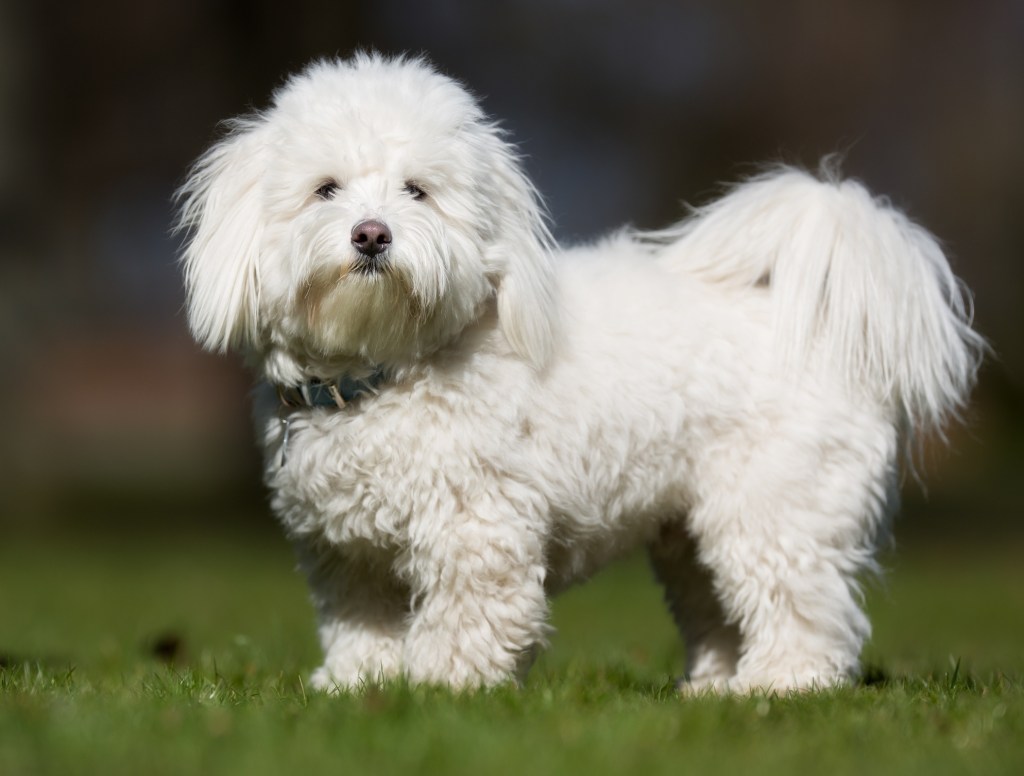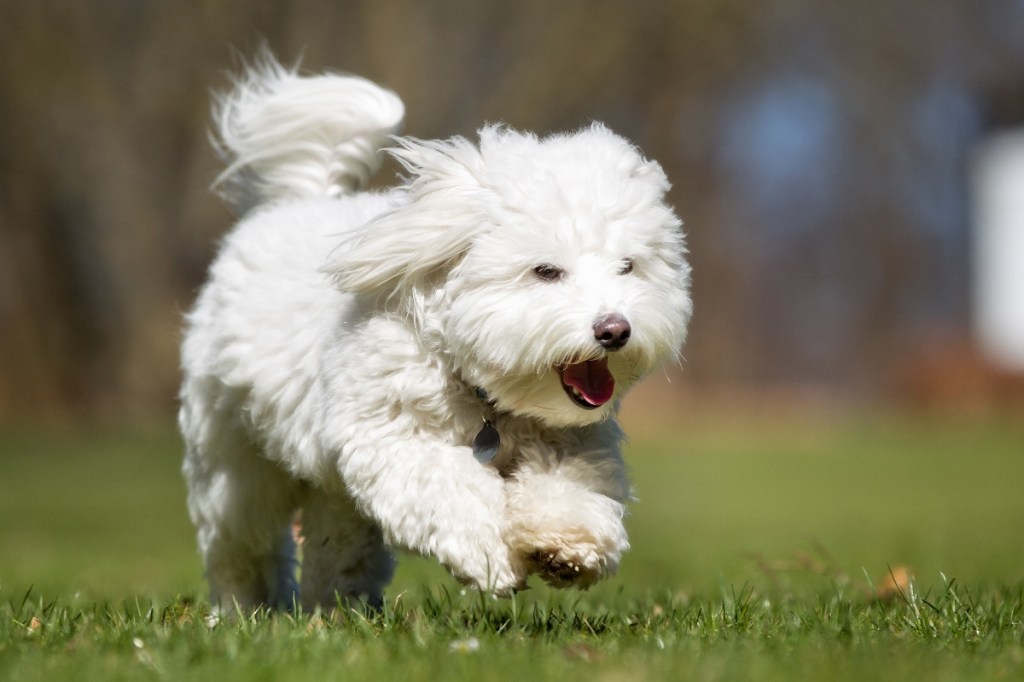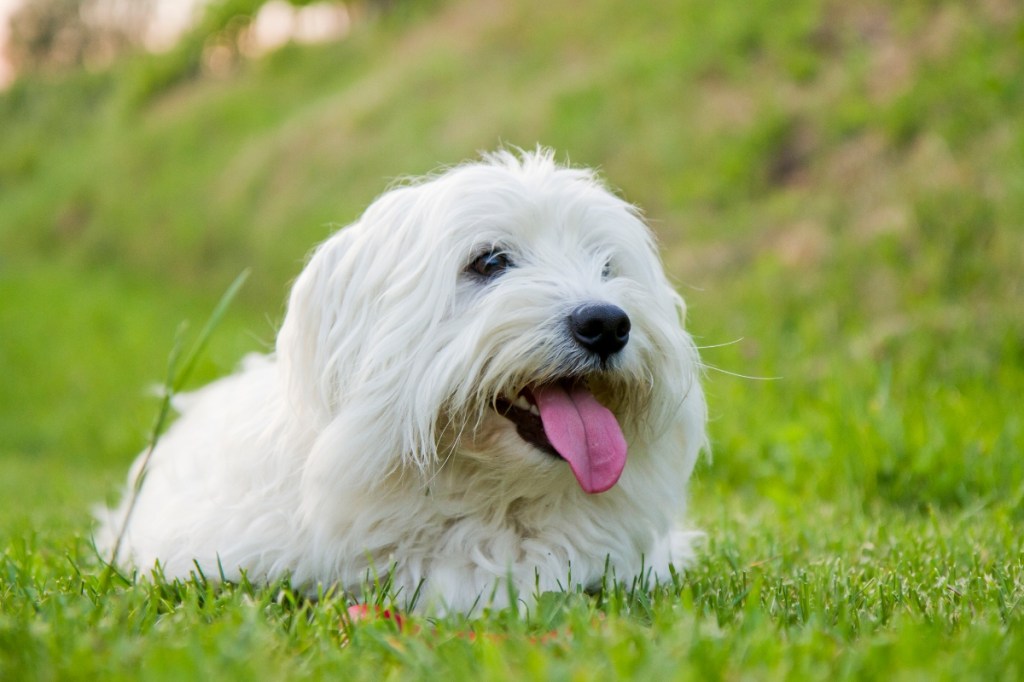Table of Contents
Introduction to Coton de Tulears
The coton de Tulear is a non-sporting group dog breed known for having happy and charming personalities. These small dogs have a long life expectancy, sturdy build, and a soft, mostly white coat resembling cotton. The dog’s coat color and texture are how the breed got its name because coton means “cotton” in French.
Coton de Tulears are wonderful companions and enjoy following their humans around the house. They are lighthearted, funny, and amusing, making them ideal dogs for anyone who wants to enjoy more of life’s simple pleasures. You’ll also find that coton de Tulears are low-maintenance, easygoing, and do well in apartments.
Curious to learn more? Read more information about the coton de Tulear breed in this Healthy Paws guide.
Size of Coton de Tulears
Coton de Tulears typically grow until they are 10 to 12 months old, with females stopping a little sooner than males. These dogs are born on the small side but grow rapidly during their first six months of life. Fully grown males weigh between nine and 15 pounds and stand 10 to 11 inches tall. Female adults are eight to 13 pounds and stand nine to 10 inches tall.
The chart below describes how big you can expect your coton de Tulear to get as the dog grows from puppyhood to adulthood. Female weights are at the low end of these ranges, and male weights are at the high end.
| Weight Chart | 3 months | 6 months | 12 months |
| Female and male coton de Tulears | 4 – 6 lbs. | 6 – 11 lbs. | 9 – 15 lbs. |

Characteristics of Coton de Tulears
The most common characteristics of coton de Tulears are sweet, cuddly, clownish, loving, and adaptable. These dogs get along with pretty much everyone and have an easygoing temperament that makes them a pleasure to be around.
Many people love their coton de Tulears because they are good travel companions, enjoy walks yet don’t have extensive exercise needs, and thrive on human companionship. Therefore, they are ideal dogs for retirees, people who work from home, and stay-at-home parents. They may bark when someone comes to the door and exhibit unique vocalizations, such as grunts, around people with whom they are comfortable.
As you get to know a coton de Tulear’s personality, here’s what you can expect based on his or her breed characteristics.
| Breed Characteristic | Level (High, Medium, Low) |
| Affectionate with People | High |
| Good with Kids | High |
| Good with Pets | High |
| Need for Exercise | Medium |
| Energy Level | Medium |
| Intelligence Level | Medium |
| Able to Be Trained | Medium |
| Amount of Barking | Medium |
| Amount of Shedding | Low |
H2: History of Coton de Tulears
The coton de Tulear dog breed originated in Madagascar, an island off the southeastern coast of Africa. They were the beloved lapdogs of nobility here and named after the seaport town of Tulear. French aristocrats in Madagascar loved these little white dogs and were insistent that they did not leave the island. Therefore, coton de Tulears were isolated from much of the world for centuries.
In the 1960s, French tourists discovered and fell in love with the breed. Their popularity quickly spread in Europe, where selective breeding refined the dogs’ characteristics for the future. The American Kennel Club registered its first dog of this breed in 2014. Since then, coton de Tulears have competed in AKC events, including obedience, rally, agility, and tracking competitions.
Coton de Tulear Standard Information
Affectionately known as the “Royal Dog of Madagascar,” the coton de Tulear is a small, sturdy, white companion dog that is bright, energetic, and lighthearted in nature. It is defined by its cotton-like coat, round and dark eyes, and tail carried happily and curved over the dog’s back. These are all characteristics by which coton de Tulears are judged at dog shows.
Here is an overview of the breed standard information for coton de Tulears:

Head:
- Short and triangular head
- Lively, alert, and happy expression
- Round and dark eyes that are brown or black
- Pendulous and triangular ears
- Slightly rounded skull
- Lean cheeks
- Straight muzzle
- Rounded triangle-shaped nose
- Scissor or level bite
Neck, Topline, Body:
- Slightly arched, moderate-length neck
- Withers are only slightly pronounced
- Body is longer than high
- Chest is long and well-developed
- Tail is low set in the axis of the spinal column
Forequarters:
- Shoulders are muscular, and shoulder blades are laid back
- Pastern is strong and sloping very slightly
- Dewclaws may be removed or left natural
- Feet are small and round
- Toes are arched and tight
- Pads are pigmented black
Hindquarters:
- Pelvis meets femur at an 80-degree angle
- Hock joint is well-defined and dry
- Rear pastern is perpendicular to the ground from all angles
- Dewclaws, feet, toes, and pads are the same as in front
Coat:
- Soft, supple, cotton-like texture
- Dense, profuse, slightly wavy
- Puppy coat is softer than adult coat
Color:
- White coat is essential
- Shadings are not desirable but minimally permitted
- Puppies under 12 months may have light tan, light brown, dark brown, gray, or chestnut colors
Gait:
- Moderate free gait and easy movement
- No sign of uneven movement
Caring for Coton de Tulears
Coton de Tulears are medium-energy dogs that are relatively easy to care for but have significant grooming requirements. They respond well to training and do best in households with people around nearly all the time.
Here are some general tips for taking the best care of a coton de Tulear:
Best Living Environments:
- Versatile dogs that do well in small apartments or larger homes
- Homes with children and other pets
- Households with seniors and retirees
Type of Exercise:
- Aim for an hour of exercise per day
- Morning and evening walks
- Games of fetch in the yard
- Accompanying pet parents on errands when safe to do so

Mental Enrichment:
- Dog sports, including agility, rally, and obedience exercises
- Puzzle toys to stimulate the mind
- Leashed “sniff” walks
Training Strategies:
- Use positive reinforcement methods with these eager-to-please dogs
- No harsh corrections
- Expose your dog to various types of people, dogs, and environments
Grooming Tips:
- Brush the coat at least three times per week
- Use a pin brush for the coat
- Break up mats and tangles on the legs, elbows, and around the ears
- Pat dry after bathing to prevent tangles
- Check ears weekly
- Trim nails as needed
- Brush teeth daily
Common Health Problems of Coton de Tulears
Coton de Tulears have one of the longest life expectancies of all dog breeds – 15 to 19 years. However, like all dog breeds, the coton de Tulear is prone to certain conditions because of its genetics and breeding history.
The Orthopedic Foundation of America (OFA) recommends that before breeding, coton de Tulears receive the following screening tests:
- Eye examination
- Luxating patella
- Heart evaluation
In addition, breeders should pick at least three of the following elective health screening tests:
- Hip evaluation (including for Legg Calve Perthes disease)
- Elbow evaluation
- Hypothyroidism
- DNA-based screening for von Willebrand’s disease, Bandera’s syndrome, degenerative myelopathy canine multifocal retinopathy, primary hyperoxaluria, hyperuricosuria, chondrodysplasia, or chondrodystrophy
Diet and Nutrition for Coton de Tulears
Most adult coton de Tulears will thrive when eating a high-quality, nutritionally complete and balanced adult dog food. Puppies should eat puppy food until they are around nine months old. These small dogs need to eat more frequently than big dogs to prevent their blood sugar levels from dropping, particularly as puppies. Therefore, you may need to feed your coton de Tulears puppy five small meals per day and keep the meals about four hours apart to prevent hypoglycemia. Adults generally do well with two to three meals a day. If you feed your coton de Tulears homemade dog food, make sure you are working from a recipe that is designed by a veterinary nutritionist and that is appropriate for your dog’s age and health status.
Feed the amount of dog food needed to keep your pet slim. You should be able to see your coton de Tulears’ waist and feel (but not see) the ribs without having to press too hard. In general, puppies need more calories per day than do adults, but a dog’s needs will vary with their activity level and other factors. Don’t leave food out all day for a coton de Tulears to graze on.
Talk to your veterinarian if you have any questions about your coton de Tulears’ diet or health.
Where to Adopt or Purchase Coton de Tulears
Pet lovers interested in bringing a coton de Tulear into their lives might start their search with the United States of America Coton de Tulear Club, which was formed in 1993 and is the AKC national parent club for the breed. The organization offers a breeder directory and rescue resources. There are other rescue organizations that you can contact for an adoptable pet, such as the United Coton de Tulear Association for Rescue and Education and Lady Grace Rescue-Coton de Tulear Rescue.
Related Breeds
If the coton de Tulear breed has captured your heart, you might also be interested to learn more about these similar and related dog breeds before choosing a new canine companion for your household:
- Maltese
- Bichon Frise
- Bolognese
- Havanese
Pet Insurance for Coton de Tulears
Once you purchase or adopt a coton de Tulear, one of the most important things to do next is enroll your pup in a pet health insurance plan. Healthy Paws offers coton de Tulear insurance that covers illnesses, accidents, emergency care, genetic conditions, breed-specific conditions, cancer, and alternative care. With a Healthy Paws policy in place, you’ll have peace of mind and feel confident that you can pay for whatever veterinary care your dog needs without worrying about the bills. You can take your coton de Tulear to any licensed vet you trust and submit the bills to us via mobile app.
Get your coton de Tulear health insurance quote today to take the very best care of your furry buddy!









